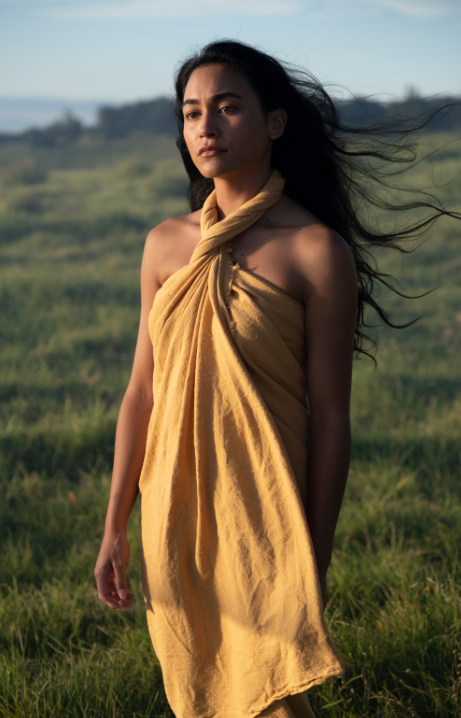
Jeanine is a Writer, Actor, member SAG/AFTRA, AEA, Podcast host,…
The Wind & the Reckoning is a film based on true events with a compelling premise, fantastic cinematography, and fight choreography placed in a lackluster script.
The film is set in 1893. Jason Scott Lee (Dragon: The Bruce Lee Story) stars as Ko’olau, a Hawiian horse trainer/cowboy. Ko’olau, his wife Pi’ilani (Lindsay Marie Anuhea Watson), and their son Kalei (Kahiau Perreira) are quietly living their lives on their land hiding the fact that Ko’oalu and Pi’ilani have early stage leprosy (Hansen’s Disease).
The problem is it’s 1893 and since there was no cure for the highly infectious disease, the American government rounds up Hawaiians who show visible signs of being infected to a leper colony on Moloka’i, the fifth largest island on Hawaii. Of course, when the families are sent to the leper colony, the government takes their land.
The Wind & the Reckoning’s title sequence draws the audience in immediately. I’m sure most people don’t know about Moloka’i because it is rural and is the least traveled of the Hawaiian Islands. Learning that for one hundred years the island was a leper colony was a surprising revelation. The costume, make-up, hair, and location instantly transport viewers back to the 19th century to a chilling effect.
The film moves to the story of Pi’ilani and Ko’olau and shows how their white neighbors discover Ko’olau and Kalei are infected and the family become fugitives, hiding in the intricate lava caves on the island on their quest to stay together. Just off of the heels of the Civil War, a small provisional Army based on Honolulu led by Officer McCabe (Henry Ian Cusick, Lost) lands to hunt and capture the family.
Ko’olau, Pi’ilani, and Kalei’s journey captures your attention because of Scott Lee Mason’s stellar cinematography and the spectacular editing of Kyle Gilbertson (Swiss Army Men). Mason (38 Minutes) does an outstanding job capturing the beautiful diversity of the Moloka’i stunning landscape. From death-defying shots of cliffs to cascading waterfalls, the film is a feast for the eyes.
As the family departs their home to seek refuge in the cliffside lava caves, the Army arrives and tracks Ko’olau and his family fairly quickly due to the skills of Marshall Hitchcock (Jonathon Schaech, Blue Ridge). Each time the family and the Army clash, I was impressed by the complex simplicity of how the fight choreography, cinematography, and editing blended effortlessly to tell the story of conflict clearly on a smaller budget film.
The actors all do a proficient job, but unfortunately the weakest element of the film is the script. The screenwriter John Fusco (Young Guns) seems stuck in the late ’90s/early ’00s. The writing reminded me of broad action films from the ’90s without any subtext or nuance. Everyone is one-dimensional, and the conflict and emotions are played broadly with actors indicating what their characters are feeling rather than embodying the roles they were cast to play.
The character development is thin and depends on the larger incredible story to keep the audience interested. Pi’ilani is the actual hero of the film, but we don’t get to know her beyond her role as wife, mother, protector. Pi’ilani is a larger-than-life historical figure, and the writer depends on her grand actions to compel the audience to root for her, which we do. But without character development and nuance, larger-than-life felt disconnected.
Watching this film reminded me of when I was watching the biopic about Harriet Tubman, Harriet — all action, no substance or connection. All we know of Ko’olau, Pi’ilani, and Kalei is their trauma. Ko’olau’s and Koala’s leprosy is discovered before the audience gets an opportunity to get a sense of the love this family has for one another outside of their trauma. Perhaps if the opening sequence was about Ko’olau and his family, instead of an unnamed mother and son disconnected from the main storyline, there could have been more of an opportunity to fall in love with these characters before they are on the run trying to survive.
I loved the actors but I was distracted by the age difference of Jason Scott Lee and Lindsay Marie Anuhea Watson as Ko’olau and Pi’ilani. The script says that Ko’olau and Pi’ilani grew up together, but Lee reads much older than Watson on film. At key moments when they were on screen I was thinking about my perception and judgments about the age gap of the actors rather than connecting to the characters.
The Wind & the Reckoning is a compelling film because it tells a part of American history that most of us never heard of. Hawaii is one of my favorite places on Earth. I’ve visited several islands several times and never knew this aspect of its rich history. Watching this film compelled me to do my research and learn more about the devastating multifaceted negative impacts of US colonization on Hawaiians and their culture.
Even though there are several moments of the script that are flawed and listless, I can respect the worthy intent the filmmakers had in bringing this story to the screen. If you are interested in supporting representation and AAPI stories, The Wind & the Reckoning is a film you can watch for the culture.
The Wind & the Reckoning opens Friday, May 12, 2023, in Los Angeles at Laemmle Monica, at Village East Cinema on Friday, May 26, and will be available to rent or purchase online on Friday, June 2, at https://www.windandreckoning.com.
What's Your Reaction?
Jeanine is a Writer, Actor, member SAG/AFTRA, AEA, Podcast host, Producer, CEO VisAbleBlackWoman Productions, Certified Health Coach and Conscious Dance facilitator. Jeanine's mission, centering Black women's stories to preserve our legacies.








